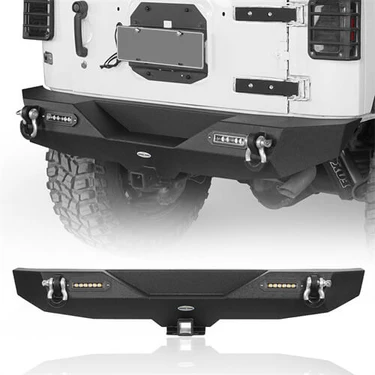Driving with a damaged rear bumper is a common concern for Jeep owners, especially for off-road enthusiasts who push their vehicles to the limit. Whether it’s a Hooke Road bumper or a rugged steel bumper, understanding the risks and options for repair or replacement is crucial.
This article explores the implications of driving with a damaged Jeep rear bumper, including the safety, legal, and functional aspects.
The Importance of Your Rear Bumper
A rear bumper is more than a cosmetic feature. Its primary purposes include:
- Impact Absorption: Reduces damage during collisions.
- Component Protection: Safeguards vital elements like the fuel tank and exhaust system.
- Off-Road Utility: For vehicles like the Jeep JK, bumpers often double as mounting points for accessories like tire carriers and tow hooks.
High-quality options, like the Hooke Road Rear Bumper, are designed for durability and performance.
Is It Safe to Drive with a Damaged Rear Bumper?
Driving with a damaged bumper may be unsafe, depending on the severity of the damage.
Safety Risks:
- Reduced Crash Protection: A damaged bumper can’t absorb impact properly, increasing injury risks in accidents.
- Exposed Components: Cracks or dents can expose your vehicle to further damage from dirt, moisture, and rust.
Functional Drawbacks:
- Off-Road Challenges: A compromised Jeep JK rear bumper can hinder towing and mounting accessories.
- Unstable Attachment: If the bumper is loose, it may detach while driving, posing a hazard to others.
Is It Legal to Drive with a Damaged Rear Bumper?
The legality varies by jurisdiction:
- Inspection Standards: Some states or countries require fully functional bumpers to pass inspections.
- Traffic Laws: A visibly damaged bumper could result in fines or penalties.
- Off-Road Regulations: Trail-ready bumpers like steel bumpers are recommended for safety in rugged environments.
Repair vs. Replacement: What’s the Best Option?
When to Repair
Minor scratches, dents, or surface-level damage can often be repaired. A simple patch-up can suffice for aesthetic and functional restoration.
When to Replace
- Severe Structural Damage: Cracks or breaks that compromise integrity require replacement.
- Upgrade Opportunity: Consider replacing your damaged bumper with a durable Hooke Road bumper or a high-strength steel bumper.
Benefits of Upgrading to a Hooke Road Bumper
- Durability: Engineered for extreme off-road conditions.
- Functionality: Provides mounting options for winches, LED lights, and more.
- Style: Enhances your Jeep’s rugged appearance.
- Compatibility: Perfect fit for models like the Jeep JK rear bumper.
FAQs
Can I drive with a cracked steel bumper?
While steel bumpers are highly durable, driving with a significant crack compromises safety and off-road functionality.
What’s the best replacement for a Jeep rear bumper?
A Hooke Road bumper is a top choice for Jeep owners, offering style, durability, and utility.
How much does it cost to replace a Jeep JK rear bumper?
Costs vary widely, ranging from $300 for basic options to over $1,500 for premium steel bumpers with advanced features.
Is a steel bumper better than a standard bumper?
Yes, steel bumpers are superior for off-roading, offering greater impact resistance and utility.
Final Thoughts
While it may seem tempting to ignore a damaged rear bumper, doing so poses safety, legal, and functional risks. Upgrading to a reliable Hooke Road bumper or steel bumper ensures you maintain the performance and appearance of your Jeep. Whether you’re navigating rugged trails or city streets, investing in a high-quality Jeep JK rear bumper keeps you and your vehicle ready for any adventure.
READ MORE BULLEYES.BLOG

